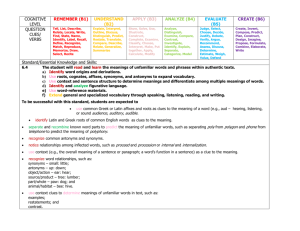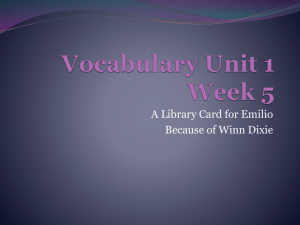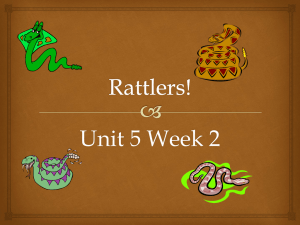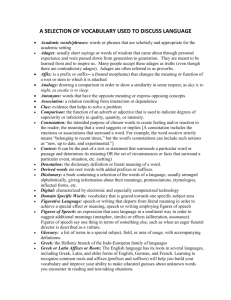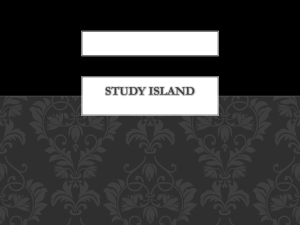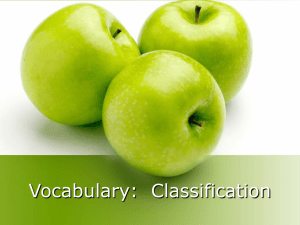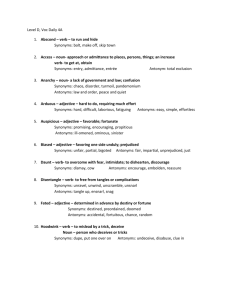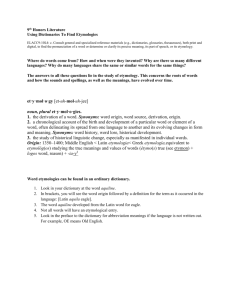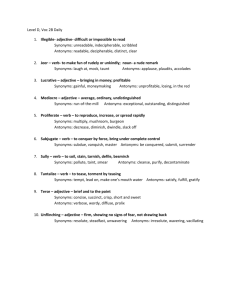Literary Standards Articulated by Grade Level-Strand 1
advertisement
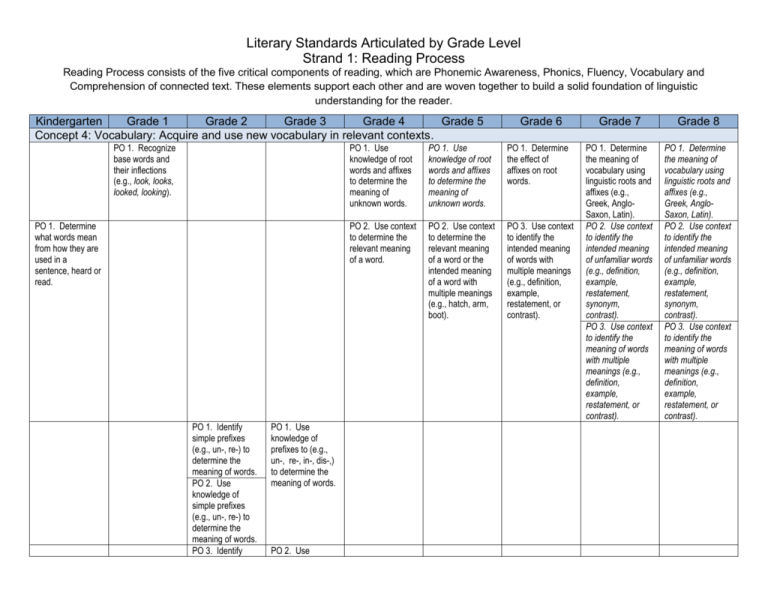
Literary Standards Articulated by Grade Level Strand 1: Reading Process Reading Process consists of the five critical components of reading, which are Phonemic Awareness, Phonics, Fluency, Vocabulary and Comprehension of connected text. These elements support each other and are woven together to build a solid foundation of linguistic understanding for the reader. Kindergarten Grade 1 Grade 2 Grade 3 Grade 4 Grade 5 Concept 4: Vocabulary: Acquire and use new vocabulary in relevant contexts. PO 1. Recognize base words and their inflections (e.g., look, looks, looked, looking). PO 1. Determine what words mean from how they are used in a sentence, heard or read. PO 1. Identify simple prefixes (e.g., un-, re-) to determine the meaning of words. PO 2. Use knowledge of simple prefixes (e.g., un-, re-) to determine the meaning of words. PO 3. Identify PO 1. Use knowledge of prefixes to (e.g., un-, re-, in-, dis-,) to determine the meaning of words. PO 2. Use Grade 6 PO 1. Use knowledge of root words and affixes to determine the meaning of unknown words. PO 1. Use knowledge of root words and affixes to determine the meaning of unknown words. PO 1. Determine the effect of affixes on root words. PO 2. Use context to determine the relevant meaning of a word. PO 2. Use context to determine the relevant meaning of a word or the intended meaning of a word with multiple meanings (e.g., hatch, arm, boot). PO 3. Use context to identify the intended meaning of words with multiple meanings (e.g., definition, example, restatement, or contrast). Grade 7 Grade 8 PO 1. Determine the meaning of vocabulary using linguistic roots and affixes (e.g., Greek, AngloSaxon, Latin). PO 2. Use context to identify the intended meaning of unfamiliar words (e.g., definition, example, restatement, synonym, contrast). PO 3. Use context to identify the meaning of words with multiple meanings (e.g., definition, example, restatement, or contrast). PO 1. Determine the meaning of vocabulary using linguistic roots and affixes (e.g., Greek, AngloSaxon, Latin). PO 2. Use context to identify the intended meaning of unfamiliar words (e.g., definition, example, restatement, synonym, contrast). PO 3. Use context to identify the meaning of words with multiple meanings (e.g., definition, example, restatement, or contrast). Literary Standards Articulated by Grade Level Strand 1: Reading Process Reading Process consists of the five critical components of reading, which are Phonemic Awareness, Phonics, Fluency, Vocabulary and Comprehension of connected text. These elements support each other and are woven together to build a solid foundation of linguistic understanding for the reader. Kindergarten PO 2. Sort familiar words into basic categories (e.g., colors, shapes, foods). Grade 1 Grade 2 Grade 3 simple suffixes (e.g., -ful, -ly) to determine the meaning of words. PO 4. Use knowledge of simple suffixes (e.g., -ful, -ly) to determine the meaning of words. knowledge of suffixes (e.g., -ful, ly, -less) to determine the meaning of words. PO 5. Recognize words represented by common abbreviations (e.g., Mr. Ave., Oct.). PO 3. Recognize words represented by common abbreviations (e.g., Mr. Ave., Oct.). Grade 4 Grade 5 PO 3. Determine the difference between figurative language and literal language. PO 4. Identify figurative language, including similes, personification, PO 3. Determine the difference between figurative language and literal language. PO 4. Determine the meaning of figurative language, including similes, Grade 6 Grade 7 Grade 8 PO 2. Classify common words into conceptual categories (e.g., animals, foods, toys). PO 3. Describe familiar objects and events in both general and specific language. PO 4. Determine the meaning of figurative language, including similes, metaphors, personification, and idioms in prose and poetry. PO 4. Determine the meaning of figurative language, including similes, metaphors, personification, and idioms in prose and poetry. PO 4. Determine the meaning of figurative language, including similes, metaphors, personification, idioms, hyperbole, and technical language. Literary Standards Articulated by Grade Level Strand 1: Reading Process Reading Process consists of the five critical components of reading, which are Phonemic Awareness, Phonics, Fluency, Vocabulary and Comprehension of connected text. These elements support each other and are woven together to build a solid foundation of linguistic understanding for the reader. Kindergarten Grade 1 PO 3. Identify the words that comprise contractions (e.g., can’t=can not, it’s=it is, aren’t=are not). PO 4. Recognize that two words can make a compound word (e.g., sailboat, football, popcorn). Grade 2 PO 6. Identify the words that comprise contractions (e.g., can’t = can not, it’s = it is, aren’t = are not). PO 7. Determine the meaning of compound words, using knowledge of individual words (e.g., lunchtime, daydream, everyday). Grade 3 PO 4. Identify the words that comprise a contraction (e.g., can’t=can not, it’s=it is, aren’t=are not). PO 5. Determine the meaning of compound words, using knowledge of individual words (e.g., lunchtime, daydream, everyday). PO 6. Determine the meaning of common synonyms, antonyms, and homonyms. PO 7. Determine the meanings and other features of words (e.g., pronunciation, syllabication, synonyms, parts of speech) using the dictionary, thesaurus, and CD-ROM and Internet when available. Grade 4 Grade 5 and idioms. personification, and idioms. PO 6. Identify antonyms, synonyms, and homonyms for given words within text. PO 5. Determine the meanings, pronunciations, syllabication, synonyms, antonyms, and parts of speech of words by using a variety of reference aids, including dictionaries, thesauri, glossaries, and CD-ROM and PO 6. Identify antonyms, synonyms, and homonyms for given words within text. PO 5. Determine the meanings, pronunciations, syllabication, synonyms, antonyms, and parts of speech of words, by using a variety of reference aids, including dictionaries, thesauri, glossaries, and CD-ROM and Grade 6 Grade 7 Grade 8 PO 5. Identify the meanings, pronunciations, syllabication, synonyms, antonyms, and parts of speech of words, by using a variety of reference aids, including dictionaries, thesauri, glossaries, and CD-ROM and the PO 5. Identify the meanings, pronunciations, syllabication, synonyms, antonyms, and parts of speech of words, by using a variety of reference aids, including dictionaries, thesauri, glossaries, and CD-ROM and the PO 5. Identify the meanings, pronunciations, syllabication, synonyms, antonyms, and parts of speech of words, by using a variety of reference aids, including dictionaries, thesauri, glossaries, and CD-ROM and the Literary Standards Articulated by Grade Level Strand 1: Reading Process Reading Process consists of the five critical components of reading, which are Phonemic Awareness, Phonics, Fluency, Vocabulary and Comprehension of connected text. These elements support each other and are woven together to build a solid foundation of linguistic understanding for the reader. Kindergarten Grade 1 Grade 2 Grade 3 Grade 4 Internet when available. Grade 5 Internet when available). Grade 6 Internet when available. Grade 7 Internet when available. Grade 8 Internet when available.

